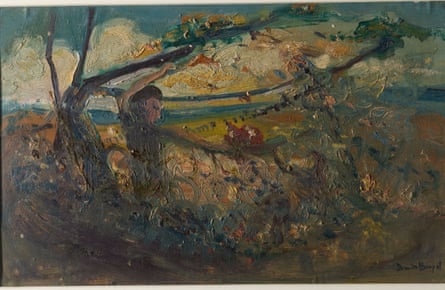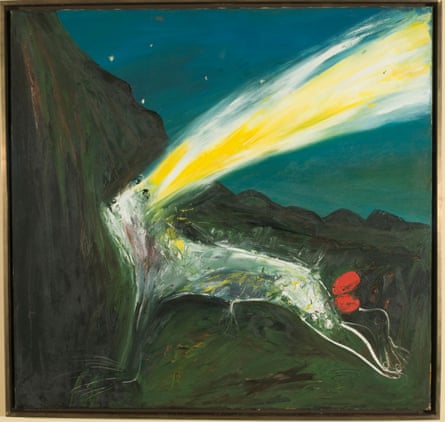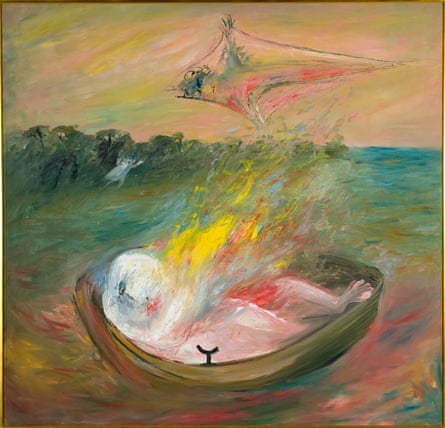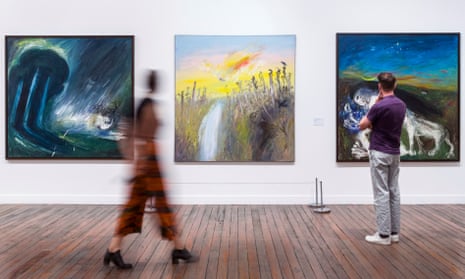Arthur Boyd’s wife Yvonne sits on a chair in the dappled light of a Suffolk forest. She is naked: her legs are slightly ajar, her breasts sagging, her hair tied back messily. She looks down, away from the viewer, as if deep in thought.
The painting – which Yvonne insisted be kept private, a moment shared by her and her husband only – has never been seen by the public before. It is the surprise jewel in Arthur Boyd: Landscape of the Soul, which opened at Sydney’s National Art School Gallery earlier this year and which will tour regional galleries until 2021.
“There is very English light, the tone is impeccable, the tone of the flesh is quietly synergising with the forest,” says the curator Barry Pearce, on a walk-through of the exhibition. “It is one of the great paintings of the female nude in Australian art.”
Pearce discovered Figure on a chair (1973) wrapped in a container at the Boyds’ Shoalhaven property Bundanon in 1992. He was immediately drawn to it: in particular to the honesty “in allowing exposure of her ageing flesh and yet projecting a great sense of dignity, humanity and beauty against the passing of time”.
Eager to include it in a major Arthur Boyd retrospective he was preparing for the Art Gallery of New South Wales, Pearce asked Yvonne’s permission. She was adamant she wanted it kept unseen, even going so far as to send a letter to Boyd’s dealers at Australian Galleries “begging them never to show it”.
It was a decision Pearce has always regretted. Now, following Yvonne’s death in 2013, he has finally felt able to reveal the work, “too magnificent to keep hidden … the legacy for us is a real aesthetic triumph”.
Landscape of the Soul ostensibly surveys the landscapes Boyd loved and painted, starting with the Mornington Peninsula, where he created many of his early works, and ending with Shoalhaven, where he lived out his later years. But it is also, more subtly, about the sway of family and loved ones. For Pearce, who knew Boyd personally for years, it is an ode to friendship.

Born in 1920 in Murrumbeena, Victoria, Boyd left school at the age of 14 to work in a factory and to concentrate on his art, attending night classes at the National Gallery School in Melbourne. As a teenager he moved in with his grandfather, Arthur Merric Boyd, on the Mornington Peninsula, where he started to paint in earnest.
Many of his early sketches and works are shown here, revealing a talented young artist who is influenced by the likes of Vincent van Gogh, but has yet to find his feet. Unusually, Pearce has included a painting by Boyd’s mother: 1928’s Figure In A Stormy Landscape. Dark in mood, and loose in brushstroke, there is a magnetic, untamed energy and movement to the work, much like Boyd’s most famous paintings.
“Of all the creative family Arthur Boyd was fortunate to grow up with … perhaps the most under-rated influence on him has been his mother Doris,” reads the accompanying text. Doris put aside her art to raise her five children. But she was, according to Pearce, the “hidden genius of the family”.

Boyd’s father, too, left a lasting impression. Merric Boyd, an artist and potter, suffered from epilepsy and debilitating seizures. This was an era when the illness was not fully understood. “They thought it was a condition where a demonic alter ego inside is released, coming out through sound, through contortion. Like the horror movies: an alien force inside the normal human body,” Pearce explains. “As a child Arthur asked, ‘What is the creature inside my father?’ The trauma entered his DNA.”
It also entered his paintings, some of which feature great beasts caught by some unseen force. In the Nebuchadnezzar series, a criticism of the Vietnam war, a Babylonian king becomes inflated with his own arrogance and importance. To punish him, God turns him to a madman who is reduced to an animal, walking on his hands and knees, growing his hair long and eating grass.
While the paintings reference everything from the Old Testament to self-immolations in protest of the war, they were also inspired by his father. In Nebuchadnezzar With Blue Flowers And White Dog (1969), a man walks, head and shoulders bent, under a dark blue sky. According to Pearce, it “projects Merric as the man of sorrows many thought of him”.
In Nebuchadnezzar In A Clearing, painted the same year, a giant, overbearing tree that dominates the composition is based on one of Merric’s drawings. A figure lies prostrate on the grass in the rain, apparently after a seizure. As Boyd told Pearce: “I had to paint these things to un-see the trauma.”
Other demons plagued Boyd, too. “One was producing commercial shows to sell – he found it very hard being enslaved to the collectors,” says Pearce. “He was constantly riven with anxiety.”
Pearce, a former curator of Australian art at the Art Gallery of NSW, often stayed with the Boyds at Bundanon, as did artists including Sidney Nolan and Brett Whiteley. (Whiteley once bent down to do up Boyd’s shoelaces for him. It was, says Pearce, “a gesture of adoration, absolutely … Arthur was very bemused.”)

Pearce considers his own friendship with Boyd as life changing. When Pearce was just nine months old his father was shot down over Germany in the second world war. Boyd asked him: “‘Does it haunt you?’ And I said, ‘yes it’s haunted me every day of my life that he didn’t come back’.” Boyd instructed Pearce to go and find his father’s grave near Munich. “You have to be close to his bones,” he said. “Your sense of trauma, your sense of loss – it helps you un-see it.”
In 1981 Boyd said: “I see lovers as victims. They suffer from being unprivate, watched. Love becomes guilt because it is frustrated.” One theme touched on in Landscape of the Soul is persecuted lovers. In 1942 Boyd was conscripted into the Australian army, where he served in the Cartographic Unit. In the first throes of love, he and Yvonne took some army blankets and spent a night in the bush, under the stars.
The next day they woke up to see that they had slept precariously close to a crevasse; not only that, but the army charged Boyd with stealing the blankets. The event helped crystallise Boyd’s hatred of the military and what it represented: destruction, death and, on a personal level, an invasion into his life.
In 1947-8, reflecting on this, he painted The Expulsion, in which Adam and Eve are driven from the Garden of Eden (in this case the Australian wilderness). The lovers, naked and exposed, flee. Eve covers her private parts with a twig; Adam clutches his head in his hands as a roaring red-headed angel bears down on them. It is a work of great angst and regret, so different to the serene calmness, years later, of the naked Yvonne.
